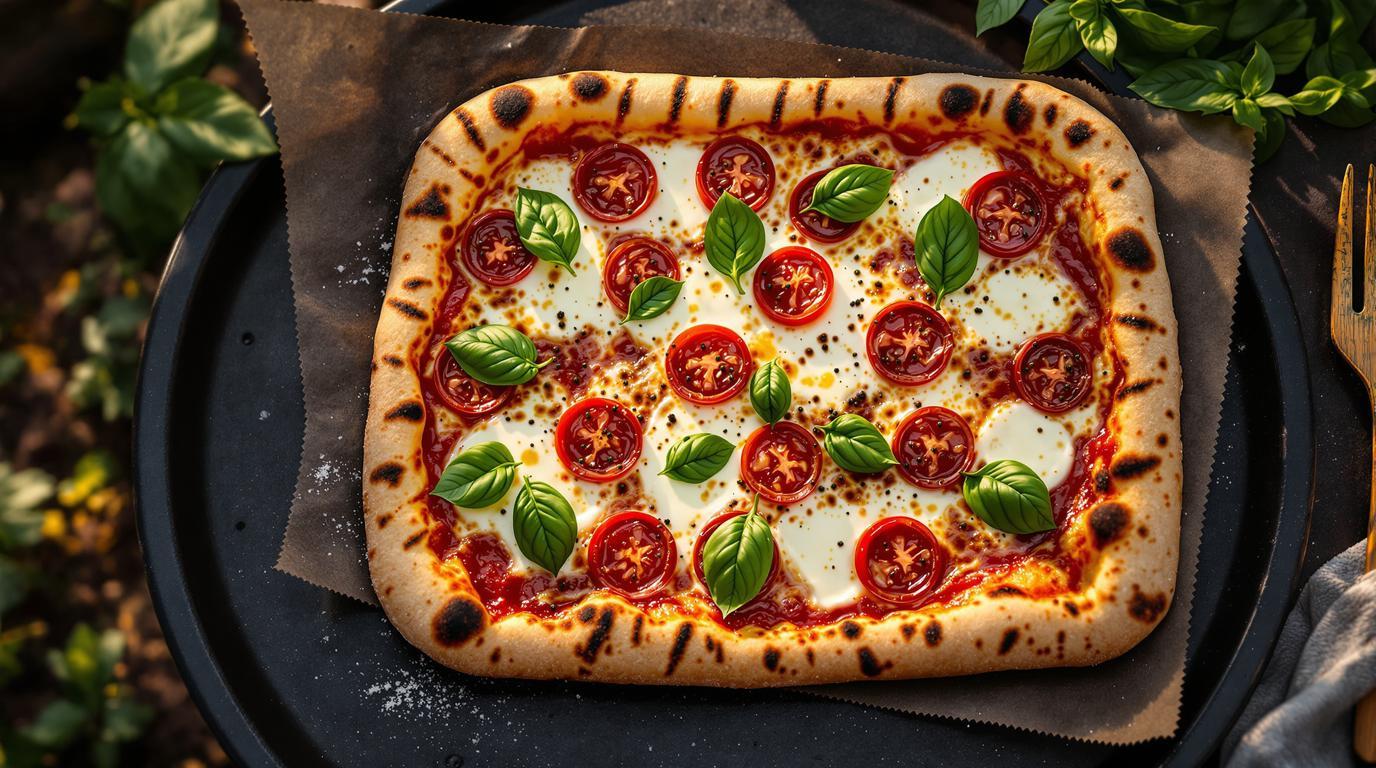There’s something almost magical about the way a grandmother’s pizza transforms on the grill. Growing up in an Italian-American household, I watched my nonna stretch dough across well-seasoned pans, creating what would later become known commercially as “Grandma Pizza.” This rectangular, thin-crust style originated in the homes of Italian immigrants on Long Island before finding its way into pizzerias across New York. Today, I’m bringing this humble masterpiece outdoors, where the kiss of live fire creates an incredible smoky dimension that even the most traditional nonna would approve of.
The Story Behind Grandma-Style Pizza 📖
Unlike its famous Neapolitan and Sicilian cousins, Grandma Pizza was born from practicality. Italian grandmothers needed to feed extended families without fancy pizza ovens, so they created a simpler style: rectangular pizzas with thin-to-medium crusts, baked in olive oil-coated sheet pans. The genius lies in its unpretentious approach—hand-crushed tomatoes applied in an uneven pattern, a modest amount of cheese, and a generous drizzle of garlic-infused olive oil. The result? A beautifully crisp bottom, chewy middle, and slightly charred edges that make you close your eyes with each bite. While fusion dishes might be trending, there’s something profoundly satisfying about returning to these authentic roots.
Essential Ingredients 🧾
For the dough:
• 1½ cups (360ml) warm water (105-110°F/40-43°C)
• 7g (1 packet) active dry yeast
• 2 tablespoons olive oil (plus ⅓ cup for coating)
• 1 tablespoon kosher salt
• 2 cups all-purpose flour + 2 cups Italian “00” flour (or 4 cups all-purpose)
For the toppings:
• 28oz (800g) canned San Marzano tomatoes, hand-crushed
• 3 cloves garlic, minced
• 12oz (340g) low-moisture mozzarella, shredded
• ½ cup Pecorino Romano, grated
• 1 teaspoon dried oregano
• Fresh basil leaves
• Extra-virgin olive oil for drizzling
Chef’s Note: The magic of Grandma Pizza comes from its cold fermentation. While you can make the dough and use it the same day, allowing it to develop in your refrigerator for 24-48 hours creates a depth of flavor that separates good pizza from exceptional pizza. This slow fermentation process allows natural enzymes to break down complex carbohydrates, creating that distinctive yeasty complexity that makes your crust taste professionally crafted.
Step-by-Step Instructions 📝
1. Prepare the dough: In a large bowl, combine warm water with yeast and 2 tablespoons olive oil. Let sit for 5 minutes until frothy. Mix in flour and salt, kneading until smooth (about 10 minutes). Drizzle ⅓ cup olive oil over the dough, cover, and refrigerate for 24-48 hours.
2. Preheat your grill: Set up your grill for indirect heat, aiming for 450°F (232°C). If you have one, place a pizza stone or steel on the grill to preheat.
3. Shape and assemble: On a floured surface, stretch the dough into a 12″×16″ rectangle. Transfer to an olive oil-coated grill-safe pan or parchment paper. Spread a thin layer of crushed tomatoes and minced garlic, leaving a 1-inch border. Distribute mozzarella evenly, then sprinkle with Pecorino and oregano.
4. Grill the pizza: Transfer to the preheated grill (on the stone if using). Close the lid and cook for 6-7 minutes until the bottom starts to brown. Rotate 180° and continue cooking for another 6-8 minutes until the cheese bubbles and the crust is crisp.
5. Finish and serve: Remove from the grill, add fresh basil leaves, and drizzle with high-quality olive oil. Cut into squares and serve immediately.
Chef’s Secret Techniques 🤫
The uneven application of sauce is intentional in Grandma Pizza—what I call “the random spread.” Don’t perfectly distribute your tomatoes; the uneven coverage creates pockets of intense tomato flavor against areas where the cheese and crust shine through. Before adding toppings, I always brush the dough with garlic-infused olive oil, which creates an invisible barrier that helps prevent sogginess while adding remarkable depth of flavor.
When grilling, patience is crucial. Resist the urge to constantly lift the lid, as this drops the temperature dramatically. And if you’ve got access to oak or fruit wood chunks, toss a small piece on your coals or in your smoker box for a subtle smokiness that beautifully complements the rich cheese and tangy tomatoes—similar to how smoke transforms feta in other recipes.
Serving & Presentation Tips 🍽️
Unlike typical pizzas, Grandma Pizza is traditionally served in squares, not triangles. This rectangular format creates perfect corner pieces with extra crispy edges that guests will fight over! I love to serve this alongside a crisp arugula salad dressed with lemon and olive oil for the perfect contrast. For wine, a bright Pinot Grigio or classic Chianti complements the pizza beautifully.
If you’re feeding a crowd, consider making several variations. While traditionalists keep it simple with cheese and tomato, Long Island versions often incorporate thinly sliced salami or provolone. For something different, you might explore balsamic glazes as a finishing touch, or even experiment with unexpected sweet elements for dessert versions.
Remember, cooking should connect us—to tradition, to loved ones, to moments worth savoring. This Grandma-style pizza might not have the glamour of wood-fired Neapolitan pies, but what it lacks in prestige, it more than makes up for in flavor and soul. It reminds us that sometimes, the most extraordinary food comes from the most ordinary kitchens, transformed by love, patience, and a little bit of fire. Whether you’re making this for a backyard gathering or a simple family dinner, you’re continuing a beautiful tradition that spans generations—and there’s nothing more delicious than that.
